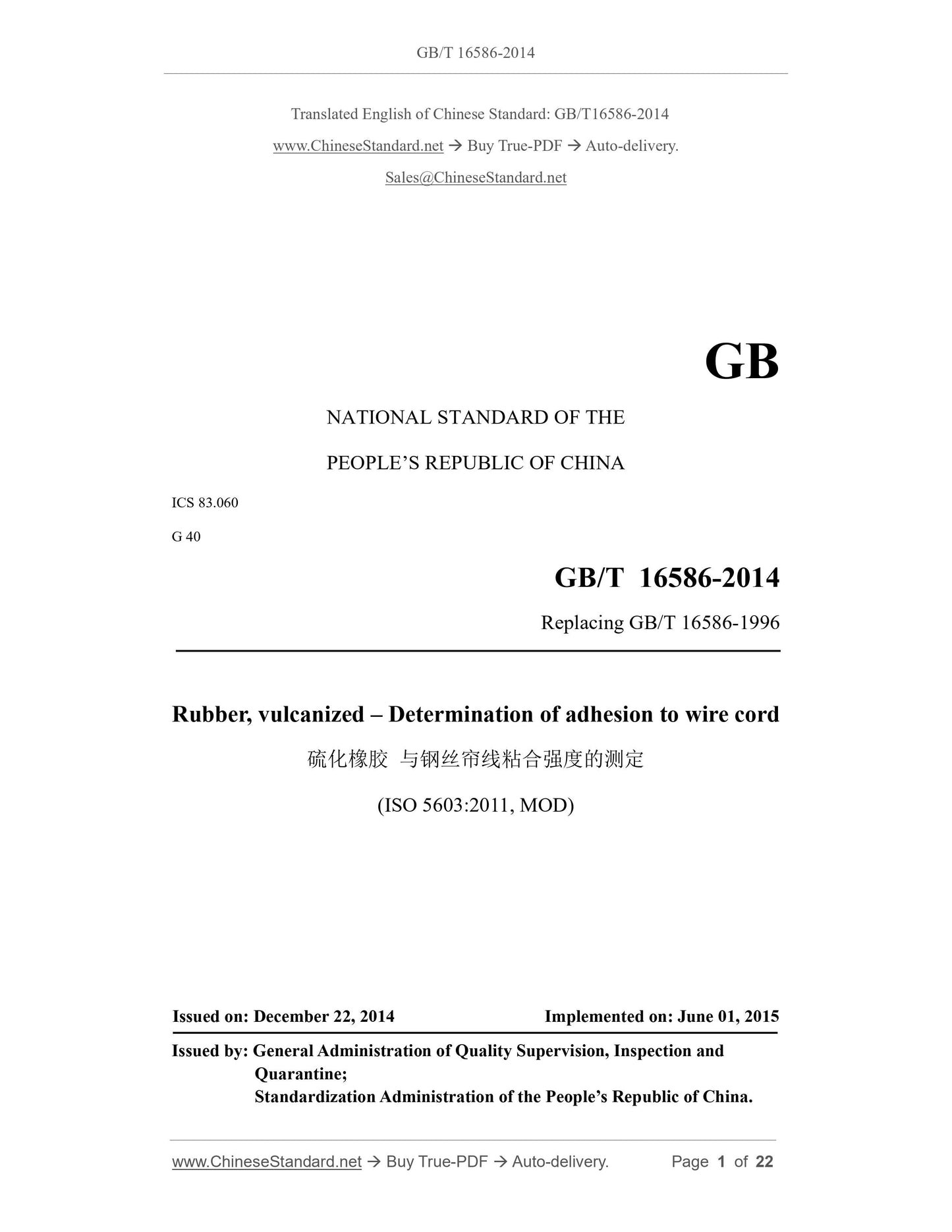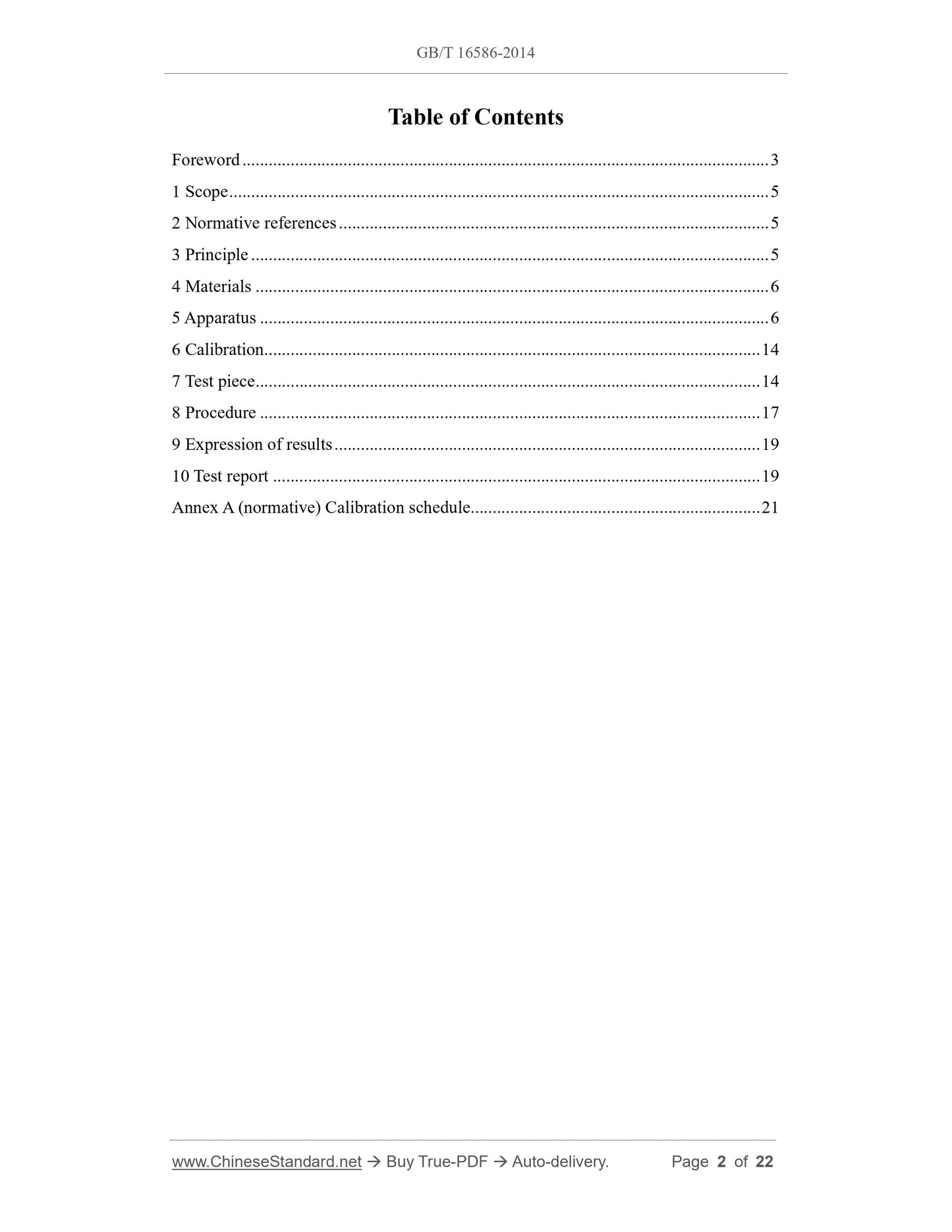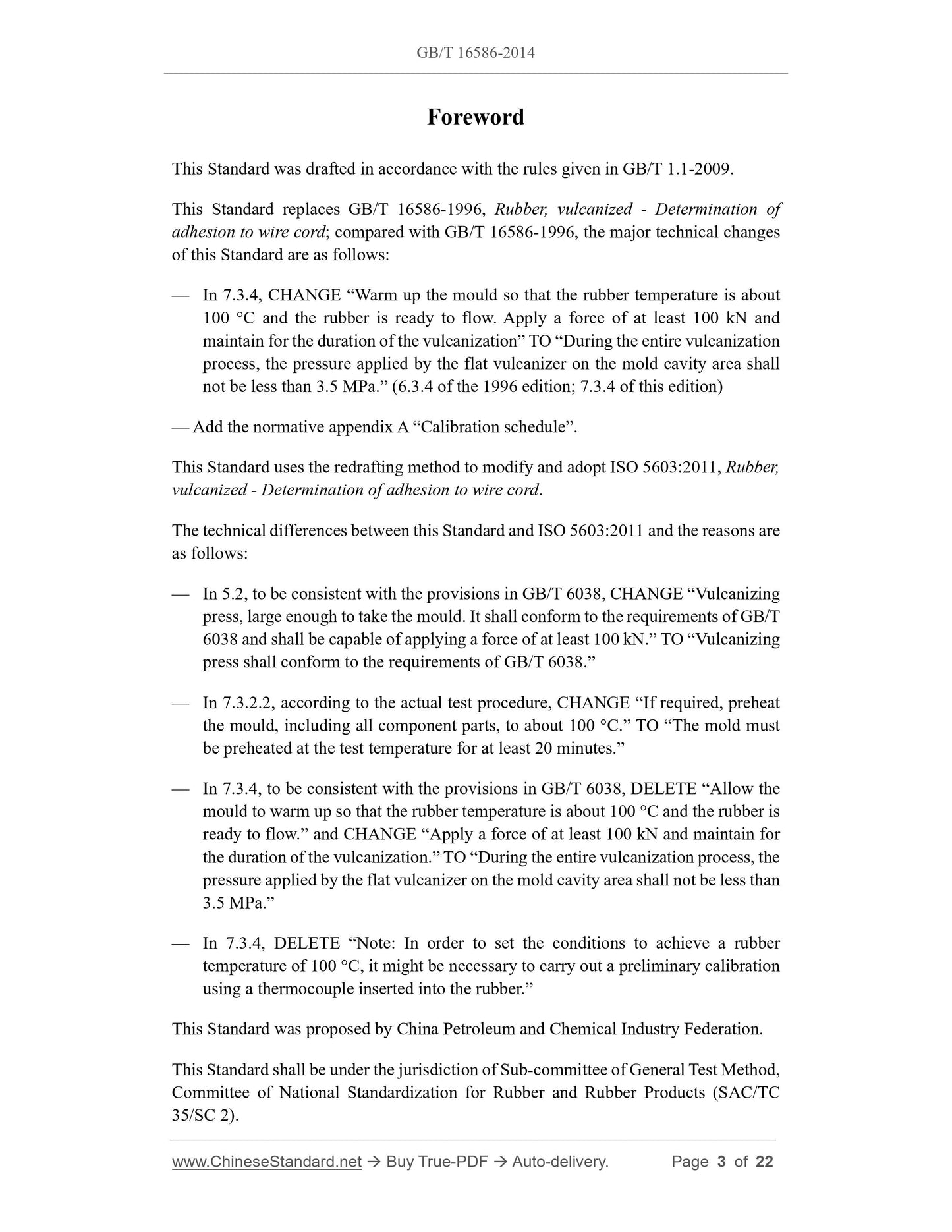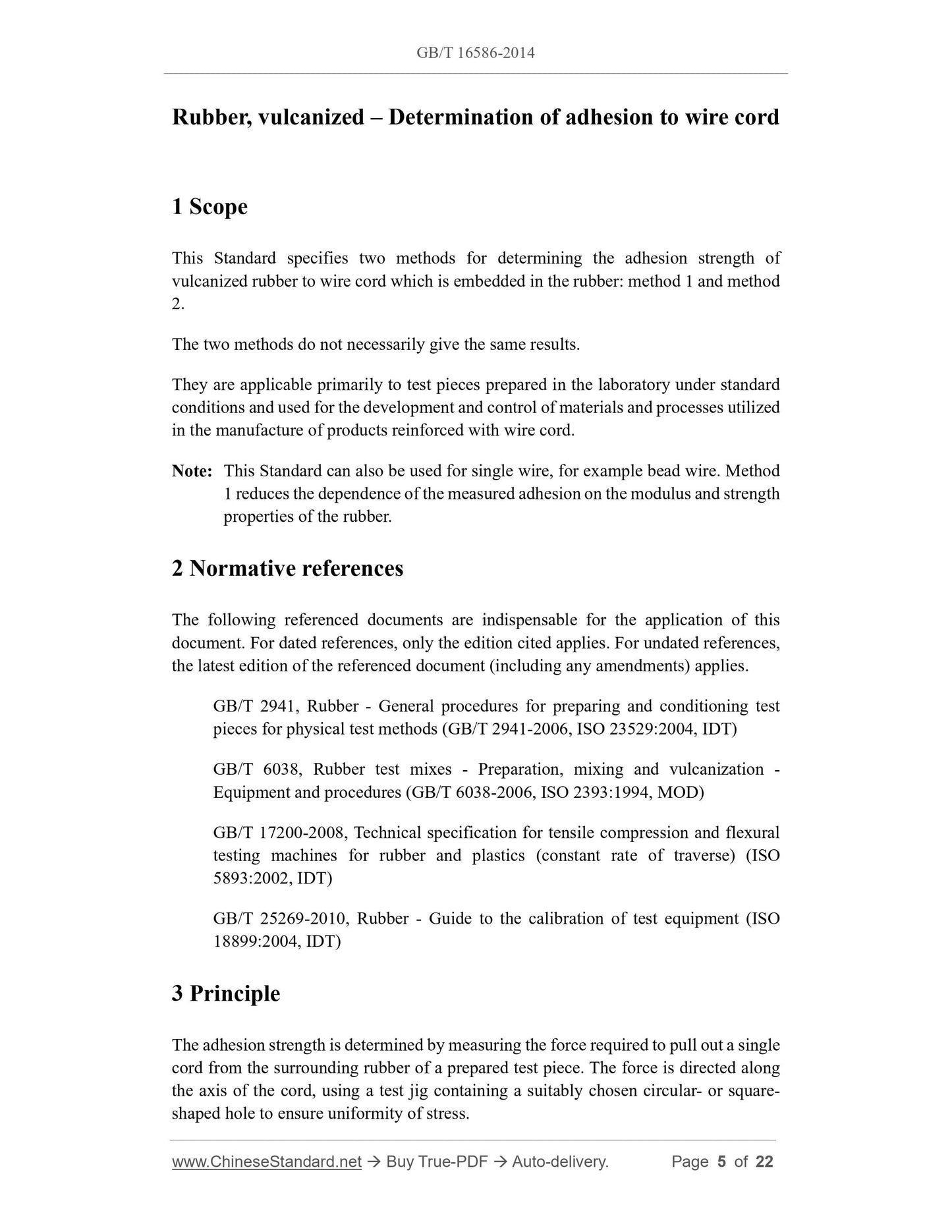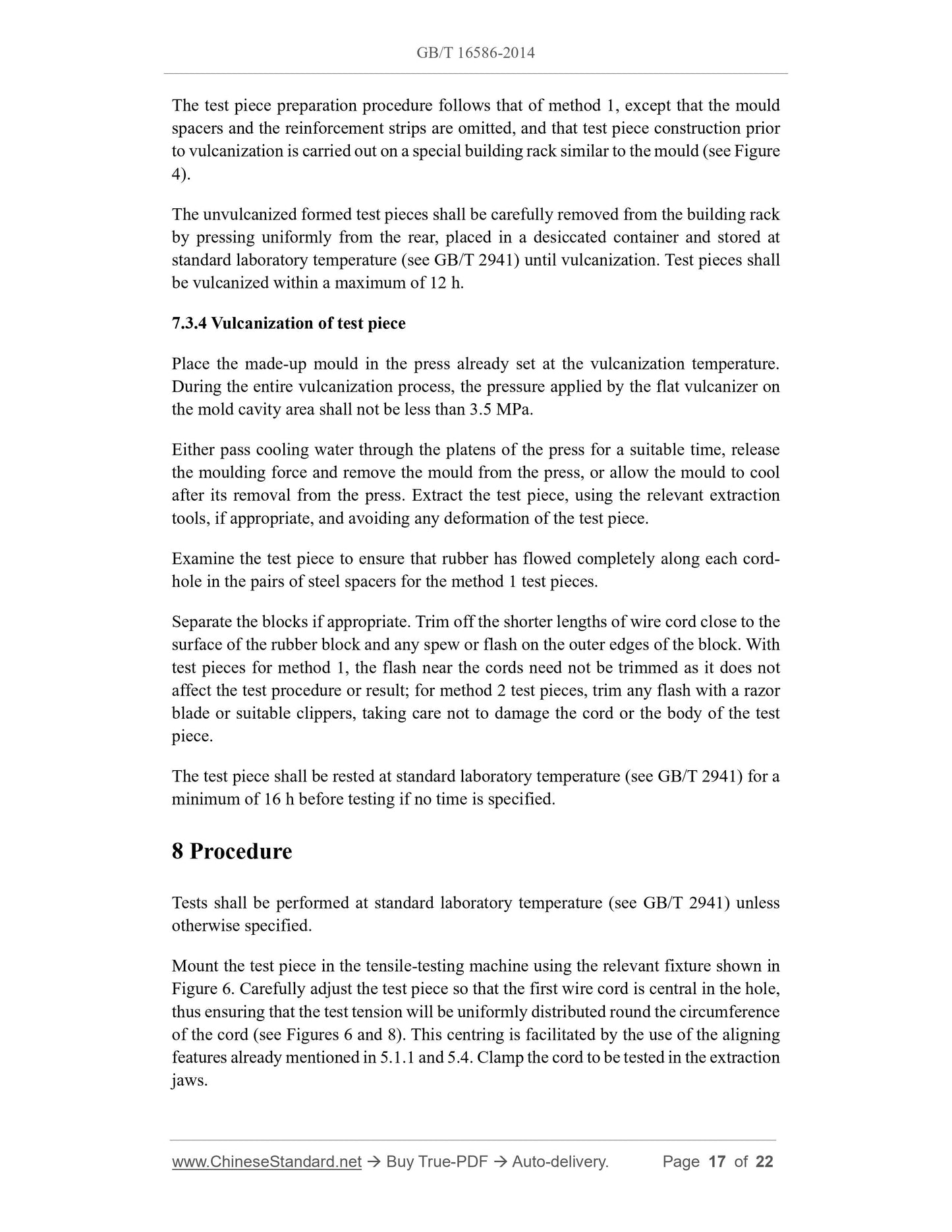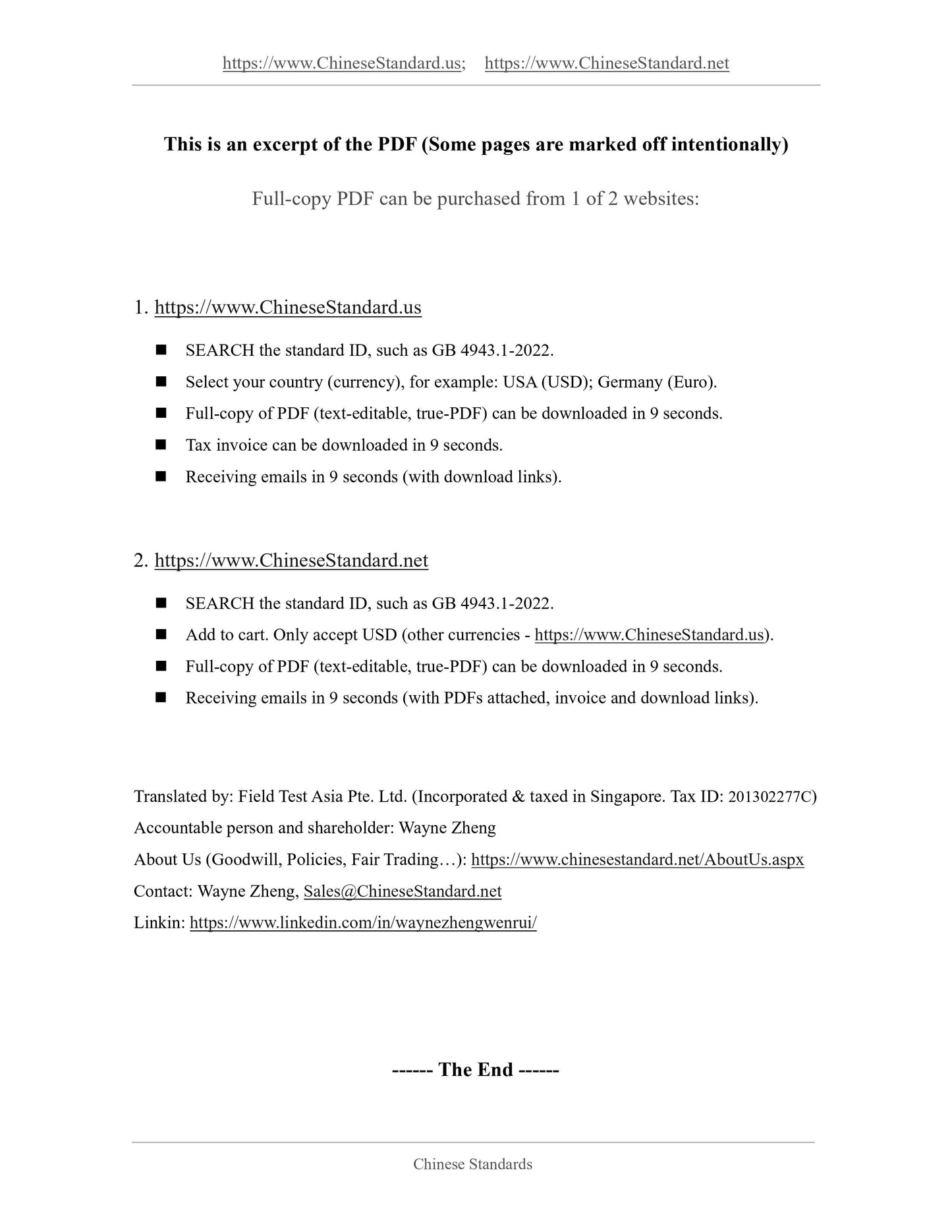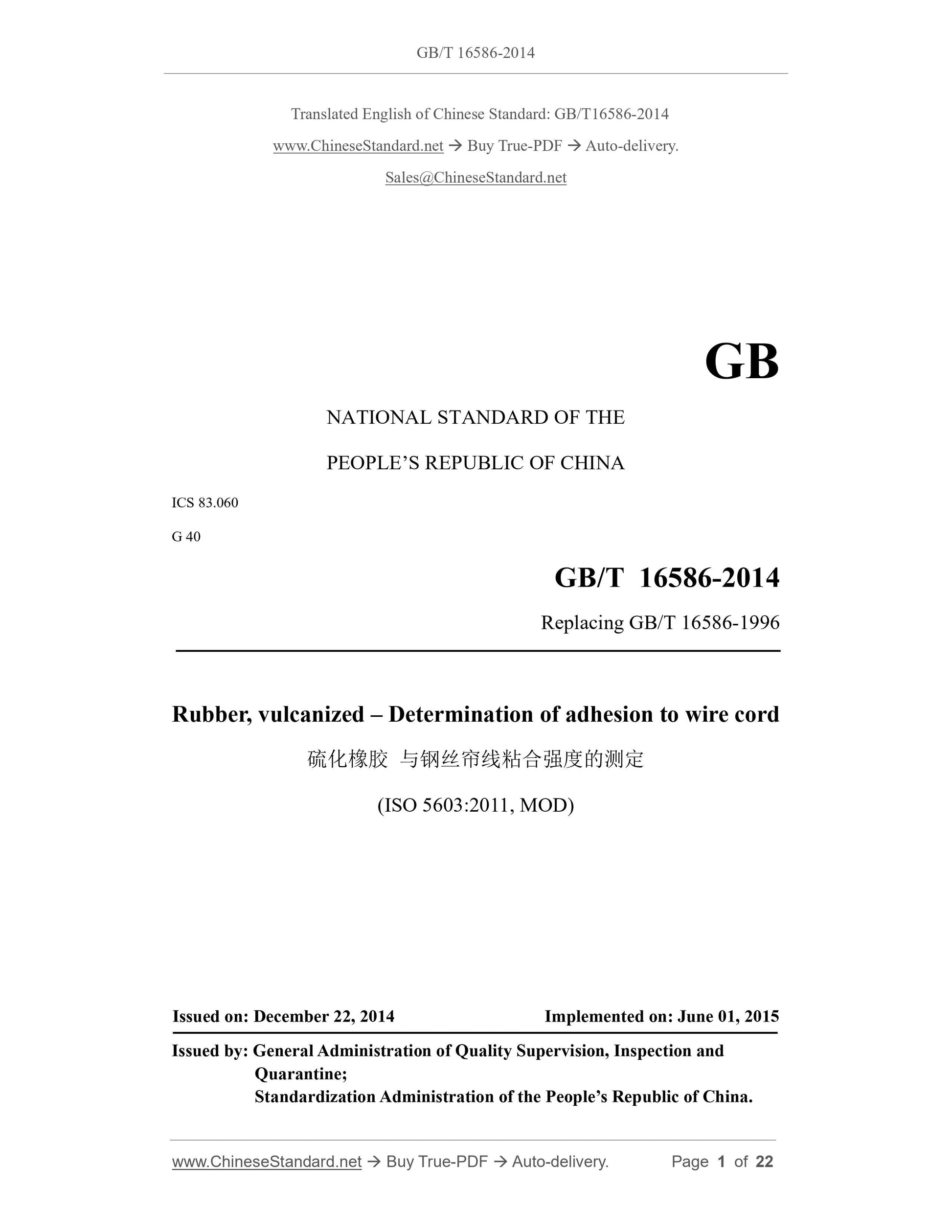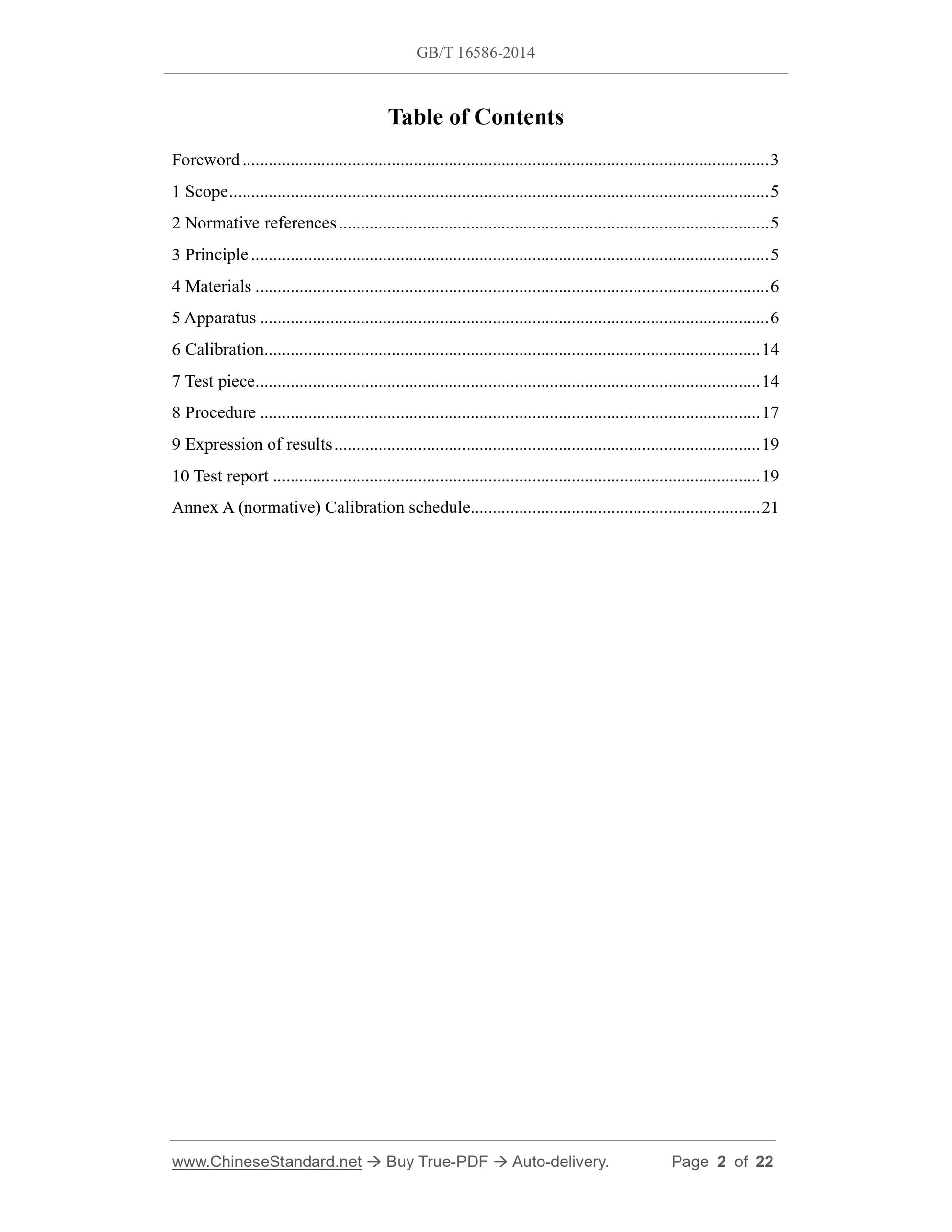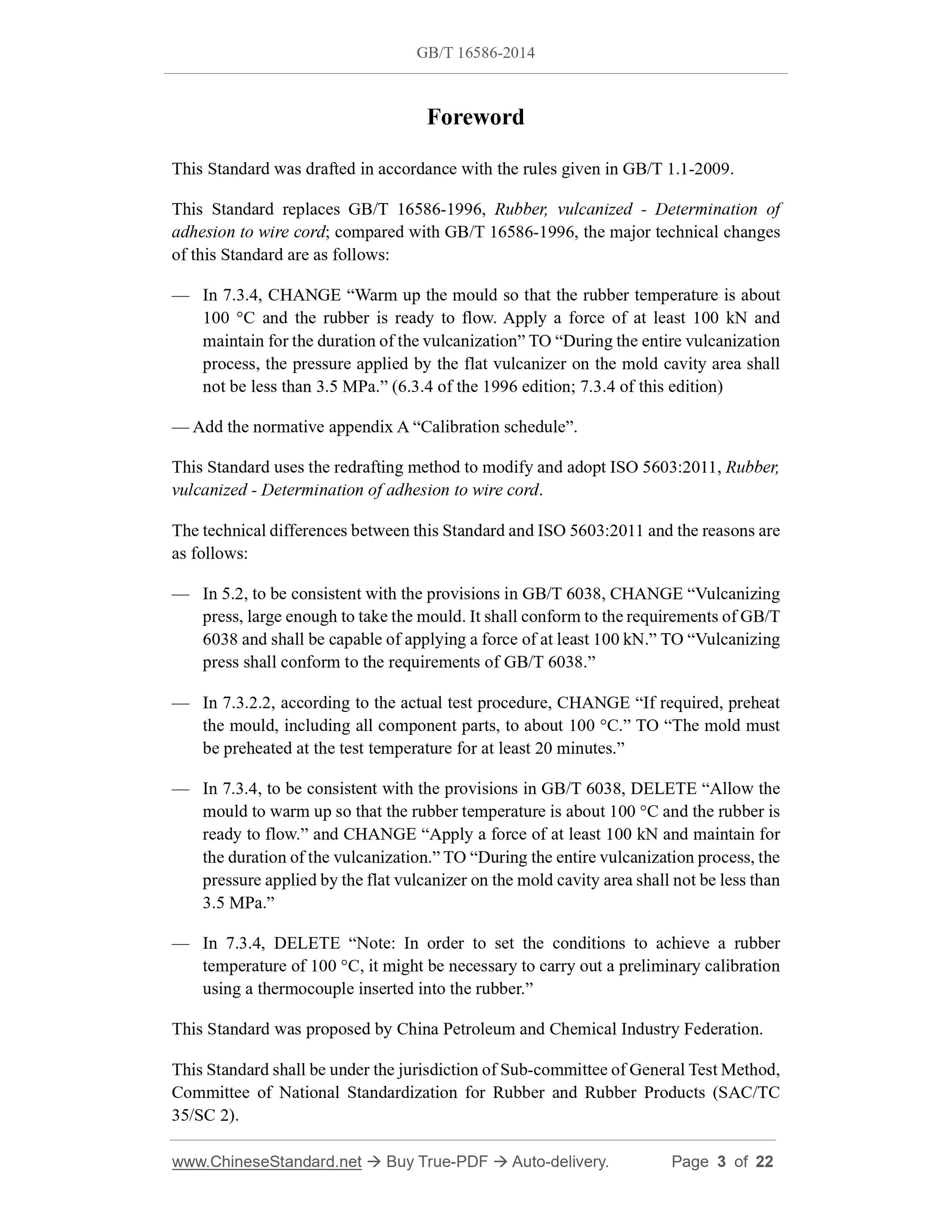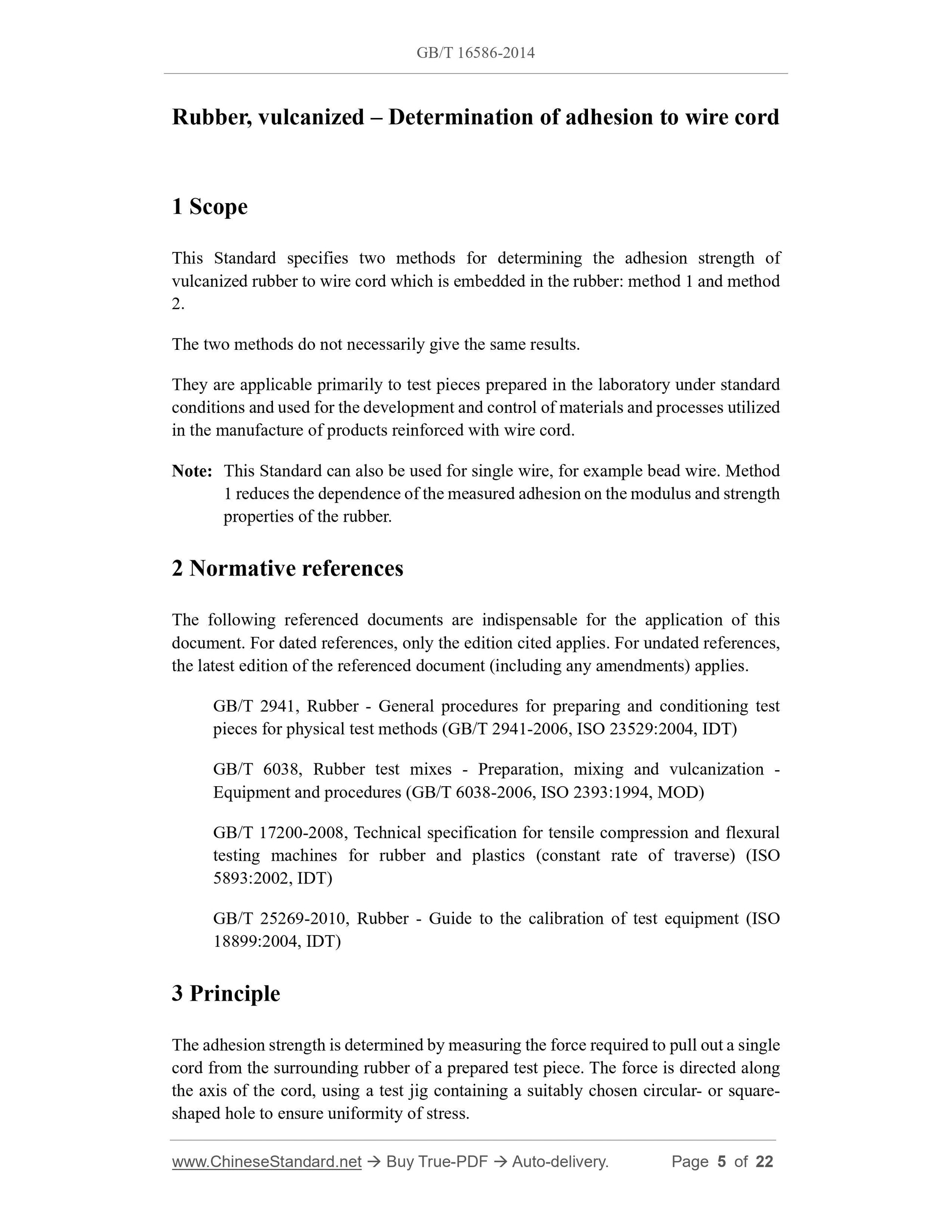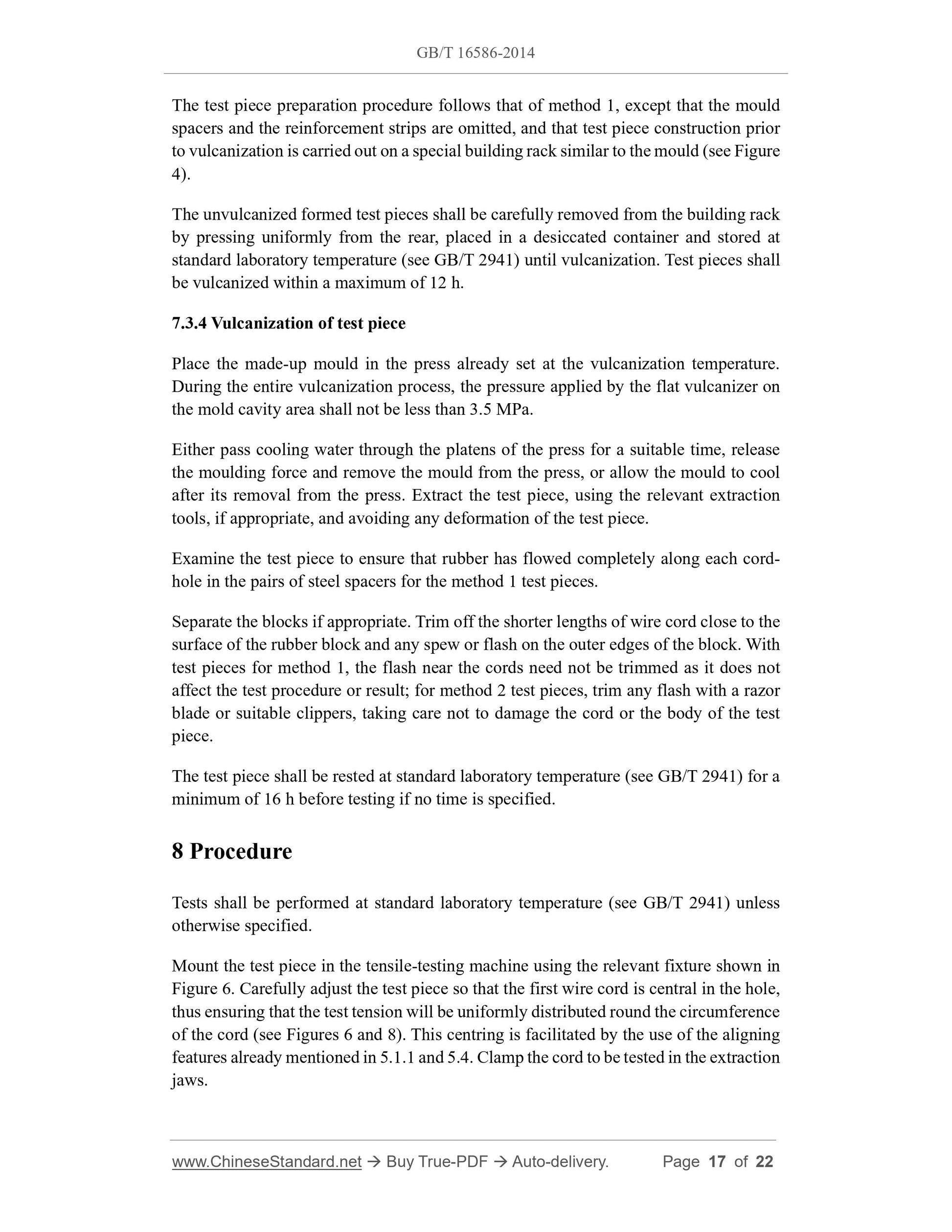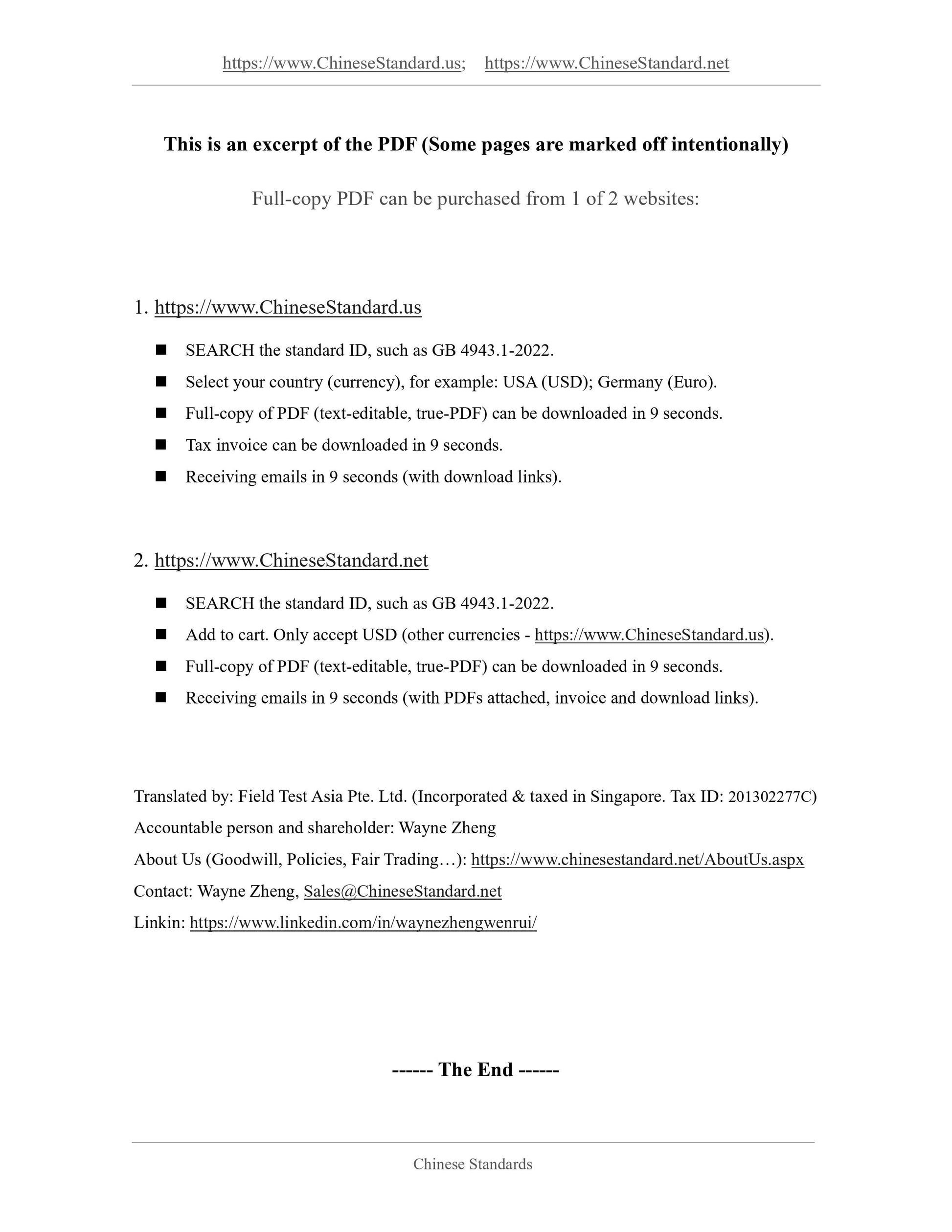1
/
of
6
PayPal, credit cards. Download editable-PDF and invoice in 1 second!
GB/T 16586-2014 English PDF (GBT16586-2014)
GB/T 16586-2014 English PDF (GBT16586-2014)
Regular price
$275.00 USD
Regular price
Sale price
$275.00 USD
Unit price
/
per
Shipping calculated at checkout.
Couldn't load pickup availability
Delivery: 3 seconds. Download true-PDF + Invoice.
Get QUOTATION in 1-minute: Click GB/T 16586-2014
Historical versions: GB/T 16586-2014
Preview True-PDF (Reload/Scroll if blank)
GB/T 16586-2014: Rubber, vulcanized -- Determination of adhesion to wire cord
GB/T 16586-2014
GB
NATIONAL STANDARD OF THE
PEOPLE’S REPUBLIC OF CHINA
ICS 83.060
G 40
Replacing GB/T 16586-1996
Rubber, vulcanized – Determination of adhesion to wire cord
(ISO 5603:2011, MOD)
ISSUED ON: DECEMBER 22, 2014
IMPLEMENTED ON: JUNE 01, 2015
Issued by: General Administration of Quality Supervision, Inspection and
Quarantine;
Standardization Administration of the People’s Republic of China.
Table of Contents
Foreword ... 3
1 Scope ... 5
2 Normative references ... 5
3 Principle ... 5
4 Materials ... 6
5 Apparatus ... 6
6 Calibration ... 14
7 Test piece ... 14
8 Procedure ... 17
9 Expression of results ... 19
10 Test report ... 19
Annex A (normative) Calibration schedule ... 21
Foreword
This Standard was drafted in accordance with the rules given in GB/T 1.1-2009.
This Standard replaces GB/T 16586-1996, Rubber, vulcanized - Determination of
adhesion to wire cord; compared with GB/T 16586-1996, the major technical changes
of this Standard are as follows:
— In 7.3.4, CHANGE “Warm up the mould so that the rubber temperature is about
100 °C and the rubber is ready to flow. Apply a force of at least 100 kN and
maintain for the duration of the vulcanization” TO “During the entire vulcanization
process, the pressure applied by the flat vulcanizer on the mold cavity area shall
not be less than 3.5 MPa.” (6.3.4 of the 1996 edition; 7.3.4 of this edition)
— Add the normative appendix A “Calibration schedule”.
This Standard uses the redrafting method to modify and adopt ISO 5603:2011, Rubber,
vulcanized - Determination of adhesion to wire cord.
The technical differences between this Standard and ISO 5603:2011 and the reasons are
as follows:
— In 5.2, to be consistent with the provisions in GB/T 6038, CHANGE “Vulcanizing
press, large enough to take the mould. It shall conform to the requirements of GB/T
6038 and shall be capable of applying a force of at least 100 kN.” TO “Vulcanizing
press shall conform to the requirements of GB/T 6038.”
— In 7.3.2.2, according to the actual test procedure, CHANGE “If required, preheat
the mould, including all component parts, to about 100 °C.” TO “The mold must
be preheated at the test temperature for at least 20 minutes.”
— In 7.3.4, to be consistent with the provisions in GB/T 6038, DELETE “Allow the
mould to warm up so that the rubber temperature is about 100 °C and the rubber is
ready to flow.” and CHANGE “Apply a force of at least 100 kN and maintain for
the duration of the vulcanization.” TO “During the entire vulcanization process, the
pressure applied by the flat vulcanizer on the mold cavity area shall not be less than
3.5 MPa.”
— In 7.3.4, DELETE “Note: In order to set the conditions to achieve a rubber
temperature of 100 °C, it might be necessary to carry out a preliminary calibration
using a thermocouple inserted into the rubber.”
This Standard was proposed by China Petroleum and Chemical Industry Federation.
This Standard shall be under the jurisdiction of Sub-committee of General Test Method,
Committee of National Standardization for Rubber and Rubber Products (SAC/TC
35/SC 2).
Rubber, vulcanized – Determination of adhesion to wire cord
1 Scope
This Standard specifies two methods for determining the adhesion strength of
vulcanized rubber to wire cord which is embedded in the rubber: method 1 and method
2.
The two methods do not necessarily give the same results.
They are applicable primarily to test pieces prepared in the laboratory under standard
conditions and used for the development and control of materials and processes utilized
in the manufacture of products reinforced with wire cord.
Note: This Standard can also be used for single wire, for example bead wire. Method
1 reduces the dependence of the measured adhesion on the modulus and strength
properties of the rubber.
2 Normative references
The following referenced documents are indispensable for the application of this
document. For dated references, only the edition cited applies. For undated references,
the latest edition of the referenced document (including any amendments) applies.
GB/T 2941, Rubber - General procedures for preparing and conditioning test
pieces for physical test methods (GB/T 2941-2006, ISO 23529:2004, IDT)
GB/T 6038, Rubber test mixes - Preparation, mixing and vulcanization -
Equipment and procedures (GB/T 6038-2006, ISO 2393:1994, MOD)
GB/T 17200-2008, Technical specification for tensile compression and flexural
testing machines for rubber and plastics (constant rate of traverse) (ISO
5893:2002, IDT)
GB/T 25269-2010, Rubber - Guide to the calibration of test equipment (ISO
18899:2004, IDT)
3 Principle
The adhesion strength is determined by measuring the force required to pull out a single
cord from the surrounding rubber of a prepared test piece. The force is directed along
the axis of the cord, using a test jig containing a suitably chosen circular- or square-
shaped hole to ensure uniformity of stress.
The test piece preparation procedure follows that of method 1, except that the mould
spacers and the reinforcement strips are omitted, and that test piece construction prior
to vulcanization is carried out on a special building rack similar to the mould (see Figure
4).
The unvulcanized formed test pieces shall be carefully removed from the building rack
by pressing uniformly from the rear, placed in a desiccated container and stored at
standard laboratory temperature (see GB/T 2941) until vulcanization. Test pieces shall
be vulcanized within a maximum of 12 h.
7.3.4 Vulcanization of test piece
Place the made-up mould in the press already set at the vulcanization temperature.
During the entire vulcanization process, the pressure applied by the flat vulcanizer on
the mold cavity area shall not be less than 3.5 MPa.
Either pass cooling water through the platens of the press for a suitable time, release
the moulding force and remove the mould from the press, or allow the mould to cool
after its removal from the press. Extract the test piece, using the relevant extraction
tools, if appropriate, and avoiding any deformation of the test piece.
Examine the test piece to ensure that rubber has flowed completely along each cord-
hole in the pairs of steel spacers for the method 1 test pieces.
Separate the blocks if appropriate. Trim off the shorter lengths of wire cord close to the
surface of the rubber block and any spew or flash on the outer edges of the block. With
test pieces for method 1, the flash near the cords need not be trimmed as it does not
affect the test procedure or result; for method 2 test pieces, trim any flash with a razor
blade or suitable clippers, taking care not to damage the cord or the body of the test
piece.
The test piece shall be rested at standard laboratory temperature (see GB/T 2941) for a
minimum of 16 h before testing if no time is specified.
8 Procedure
Tests shall be performed at standard laboratory temperature (see GB/T 2941) unless
otherwise specified.
Mount the test piece in the tensile-testing machine using the relevant fixture shown in
Figure 6. Carefully adjust the test piece so that the first wire cord is central in the hole,
thus ensuring that the test tension will be uniformly distributed round the circumference
of the cord (see Figures 6 and 8). This centring is facilitated by the use of the aligning
features already mentioned in 5.1.1 and 5.4. Clamp the cord to be tested in...
Get QUOTATION in 1-minute: Click GB/T 16586-2014
Historical versions: GB/T 16586-2014
Preview True-PDF (Reload/Scroll if blank)
GB/T 16586-2014: Rubber, vulcanized -- Determination of adhesion to wire cord
GB/T 16586-2014
GB
NATIONAL STANDARD OF THE
PEOPLE’S REPUBLIC OF CHINA
ICS 83.060
G 40
Replacing GB/T 16586-1996
Rubber, vulcanized – Determination of adhesion to wire cord
(ISO 5603:2011, MOD)
ISSUED ON: DECEMBER 22, 2014
IMPLEMENTED ON: JUNE 01, 2015
Issued by: General Administration of Quality Supervision, Inspection and
Quarantine;
Standardization Administration of the People’s Republic of China.
Table of Contents
Foreword ... 3
1 Scope ... 5
2 Normative references ... 5
3 Principle ... 5
4 Materials ... 6
5 Apparatus ... 6
6 Calibration ... 14
7 Test piece ... 14
8 Procedure ... 17
9 Expression of results ... 19
10 Test report ... 19
Annex A (normative) Calibration schedule ... 21
Foreword
This Standard was drafted in accordance with the rules given in GB/T 1.1-2009.
This Standard replaces GB/T 16586-1996, Rubber, vulcanized - Determination of
adhesion to wire cord; compared with GB/T 16586-1996, the major technical changes
of this Standard are as follows:
— In 7.3.4, CHANGE “Warm up the mould so that the rubber temperature is about
100 °C and the rubber is ready to flow. Apply a force of at least 100 kN and
maintain for the duration of the vulcanization” TO “During the entire vulcanization
process, the pressure applied by the flat vulcanizer on the mold cavity area shall
not be less than 3.5 MPa.” (6.3.4 of the 1996 edition; 7.3.4 of this edition)
— Add the normative appendix A “Calibration schedule”.
This Standard uses the redrafting method to modify and adopt ISO 5603:2011, Rubber,
vulcanized - Determination of adhesion to wire cord.
The technical differences between this Standard and ISO 5603:2011 and the reasons are
as follows:
— In 5.2, to be consistent with the provisions in GB/T 6038, CHANGE “Vulcanizing
press, large enough to take the mould. It shall conform to the requirements of GB/T
6038 and shall be capable of applying a force of at least 100 kN.” TO “Vulcanizing
press shall conform to the requirements of GB/T 6038.”
— In 7.3.2.2, according to the actual test procedure, CHANGE “If required, preheat
the mould, including all component parts, to about 100 °C.” TO “The mold must
be preheated at the test temperature for at least 20 minutes.”
— In 7.3.4, to be consistent with the provisions in GB/T 6038, DELETE “Allow the
mould to warm up so that the rubber temperature is about 100 °C and the rubber is
ready to flow.” and CHANGE “Apply a force of at least 100 kN and maintain for
the duration of the vulcanization.” TO “During the entire vulcanization process, the
pressure applied by the flat vulcanizer on the mold cavity area shall not be less than
3.5 MPa.”
— In 7.3.4, DELETE “Note: In order to set the conditions to achieve a rubber
temperature of 100 °C, it might be necessary to carry out a preliminary calibration
using a thermocouple inserted into the rubber.”
This Standard was proposed by China Petroleum and Chemical Industry Federation.
This Standard shall be under the jurisdiction of Sub-committee of General Test Method,
Committee of National Standardization for Rubber and Rubber Products (SAC/TC
35/SC 2).
Rubber, vulcanized – Determination of adhesion to wire cord
1 Scope
This Standard specifies two methods for determining the adhesion strength of
vulcanized rubber to wire cord which is embedded in the rubber: method 1 and method
2.
The two methods do not necessarily give the same results.
They are applicable primarily to test pieces prepared in the laboratory under standard
conditions and used for the development and control of materials and processes utilized
in the manufacture of products reinforced with wire cord.
Note: This Standard can also be used for single wire, for example bead wire. Method
1 reduces the dependence of the measured adhesion on the modulus and strength
properties of the rubber.
2 Normative references
The following referenced documents are indispensable for the application of this
document. For dated references, only the edition cited applies. For undated references,
the latest edition of the referenced document (including any amendments) applies.
GB/T 2941, Rubber - General procedures for preparing and conditioning test
pieces for physical test methods (GB/T 2941-2006, ISO 23529:2004, IDT)
GB/T 6038, Rubber test mixes - Preparation, mixing and vulcanization -
Equipment and procedures (GB/T 6038-2006, ISO 2393:1994, MOD)
GB/T 17200-2008, Technical specification for tensile compression and flexural
testing machines for rubber and plastics (constant rate of traverse) (ISO
5893:2002, IDT)
GB/T 25269-2010, Rubber - Guide to the calibration of test equipment (ISO
18899:2004, IDT)
3 Principle
The adhesion strength is determined by measuring the force required to pull out a single
cord from the surrounding rubber of a prepared test piece. The force is directed along
the axis of the cord, using a test jig containing a suitably chosen circular- or square-
shaped hole to ensure uniformity of stress.
The test piece preparation procedure follows that of method 1, except that the mould
spacers and the reinforcement strips are omitted, and that test piece construction prior
to vulcanization is carried out on a special building rack similar to the mould (see Figure
4).
The unvulcanized formed test pieces shall be carefully removed from the building rack
by pressing uniformly from the rear, placed in a desiccated container and stored at
standard laboratory temperature (see GB/T 2941) until vulcanization. Test pieces shall
be vulcanized within a maximum of 12 h.
7.3.4 Vulcanization of test piece
Place the made-up mould in the press already set at the vulcanization temperature.
During the entire vulcanization process, the pressure applied by the flat vulcanizer on
the mold cavity area shall not be less than 3.5 MPa.
Either pass cooling water through the platens of the press for a suitable time, release
the moulding force and remove the mould from the press, or allow the mould to cool
after its removal from the press. Extract the test piece, using the relevant extraction
tools, if appropriate, and avoiding any deformation of the test piece.
Examine the test piece to ensure that rubber has flowed completely along each cord-
hole in the pairs of steel spacers for the method 1 test pieces.
Separate the blocks if appropriate. Trim off the shorter lengths of wire cord close to the
surface of the rubber block and any spew or flash on the outer edges of the block. With
test pieces for method 1, the flash near the cords need not be trimmed as it does not
affect the test procedure or result; for method 2 test pieces, trim any flash with a razor
blade or suitable clippers, taking care not to damage the cord or the body of the test
piece.
The test piece shall be rested at standard laboratory temperature (see GB/T 2941) for a
minimum of 16 h before testing if no time is specified.
8 Procedure
Tests shall be performed at standard laboratory temperature (see GB/T 2941) unless
otherwise specified.
Mount the test piece in the tensile-testing machine using the relevant fixture shown in
Figure 6. Carefully adjust the test piece so that the first wire cord is central in the hole,
thus ensuring that the test tension will be uniformly distributed round the circumference
of the cord (see Figures 6 and 8). This centring is facilitated by the use of the aligning
features already mentioned in 5.1.1 and 5.4. Clamp the cord to be tested in...
Share
